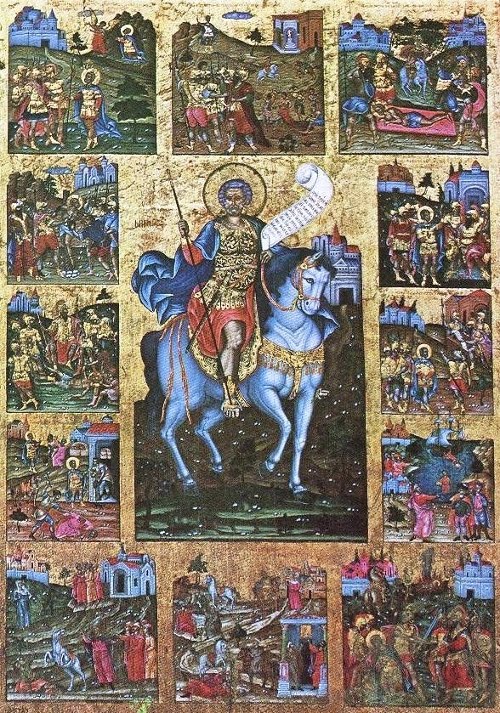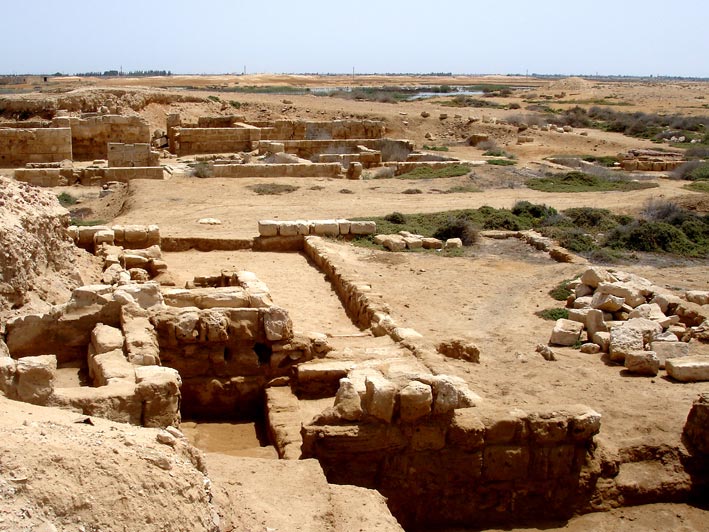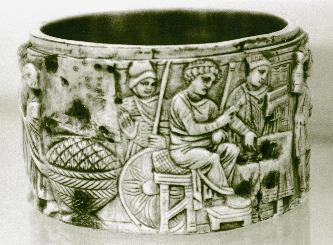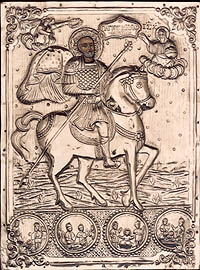It is known that St. Menas was born in the year 285 A.D. in Egypt in a pious family, his parents were Eudixius and Euphemia. His parents had long been awaiting to have children. During a feast dedicated to the Virgin Mary, Euphemia was praying with tears to an icon of the Most Holy Mother of God to grant her a child, and at the end of her prayer, the Mother of God had answered from her icon “Amen”.
Months later, the blessed child Mina was to be born. His father died when Mina was 11 years old and his mother when he was only 14. At the age of 15, he joined the Roman army, where he was given a senior grade because of his father’s inheritance.
He served in Algeria for 3 years as a soldier. This occurred at the time of the pagan Roman emperors Diocletian and Maximilian, who ordered that all Christians who will not bow to idols be tortured and killed. Disgusted and sickened of the view of Christians forced to worship idols, Menas left for the desert for 5 years leading a hermit life in fasting and prayer to the true Christian God.
During the fifth year of his ascetic life, St. Menas had a revelation when he saw an angel crowning Holy Martyrs; while contemplating this image, he heard a voice saying: “Be blessed Menas, you have been called to a pious life since your childhood. You will be crowned with three crowns: one for your clean life in celibacy, second for your ascetic struggle, and the third for martyrdom “.
With his soul filled by the fiery love for Christ and strengthen by this revelation, Menas came down from the mountains, stood in the middle of the idolaters and confessed Christ. For this, he was given to torment: his body was rubbed with tarsi, burned by fire, dragged mercilessly over thistles, and pierced at the end by a sword. St. Menas received martyrdom in the year 309, in Frigia.
It is said that the soldiers who killed Menas, threw his body on fire, but for 3 days the saint’ body did not burned. His sister along with some soldiers took the saint’ body to Alexandria and placed it in a church. When the persecution against Christians had stopped, it is said that an angel appeared to Pope Athanasius of Alexandria, instructing him to remove the saint body, place it on a camel and take it to the WesternDesert. In a certain place, not far from Alexandria, at the end of LakeMariot, the camel no longer could move, no matter how hard Christians have tried to do push it forward. They understood this to be a sign from God, and buried the saint’ body there.
For several centuries, the martyred soldier Menas was no longer know, until in a certain place in the desert, the sicken sheep’s of a pastor were miraculously healed along with the pastor. The news spread quickly and many sick people start heading to that place, without even knowing the source of these healings. The place had become so familiar that even the Emperor daughter from Constantinople (Constantine the Great or Zeno), been sick with leprosy, was sent there for healing. One night when the girl was sleeping, the Great Martyr Menas appeared to her in a dream and uncovered the mystery: his holy relics were at the place of healing. St Menas asked the girl that a church will to build in his honor. Next morning, the girl was cured and she revealed her dream to the servant accompanying her.
On that site, 45 km southwest of Alexandria, the Emperor of Constantinople not only that he ordered the building of a cathedral, but an entire city was built, including streets, buildings, churches and the Baptistery, a building with two wings for the sick (one for men and the other for women and children).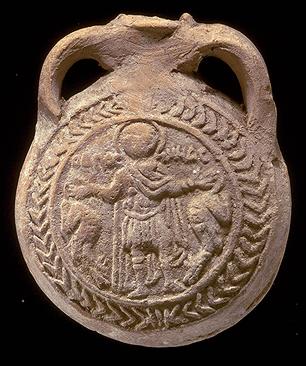 The City of St Menas (Abu Mena) has became one of the most famous place of healing and pilgrimage for many Christians. Bottles of oil and holy water engraved with the saint name were found in archeological sites of various Mediterranean countries such as: in Heidelberg – Germany, Milan – Italy, Dalmatia – Croatia, Marseille – France, Dongola – Sudan and in Jerusalem. At the middle of VII century, the city was destroyed by the Muslims.
The City of St Menas (Abu Mena) has became one of the most famous place of healing and pilgrimage for many Christians. Bottles of oil and holy water engraved with the saint name were found in archeological sites of various Mediterranean countries such as: in Heidelberg – Germany, Milan – Italy, Dalmatia – Croatia, Marseille – France, Dongola – Sudan and in Jerusalem. At the middle of VII century, the city was destroyed by the Muslims.
The first excavation to uncover the archaeological value of the site Abu Mena began between 1905 and 1907.
Five Miracles of Saint Menas
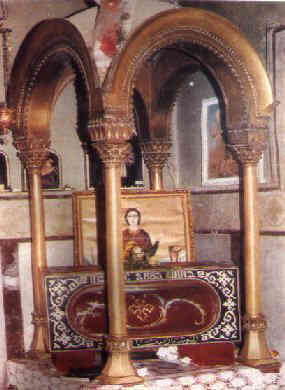 One of the most popular pilgrimage centers of the early Middle Ages was located in the Egyptian desert southwest of Alexandria and Lake Mareotis and consisted of a large complex of buildings whose full extent was brought to light by the excavations of Carl Maria Kauffmann in 1905. St. Sophronios of Jerusalem in the early seventh century described the Saint’s shrine as “the pride of all Lybia”. The following five miracles are taken from the account of miracles gathered by Patriarch Timothy of Alexandria (380-384).1. There was a man once who having gone to pray at the saint’s church was given a place to stay by a certain individual. And because the man who received him realized that the guest was carrying gold on his person, he got up in the middle of the night and set upon him with a murderous hand. And cutting his body into pieces he put him in a basket, suspended it, and waited for morning. And then he was filled with anxiety about when and where he might take (the remains) to hide them in some remote place.
One of the most popular pilgrimage centers of the early Middle Ages was located in the Egyptian desert southwest of Alexandria and Lake Mareotis and consisted of a large complex of buildings whose full extent was brought to light by the excavations of Carl Maria Kauffmann in 1905. St. Sophronios of Jerusalem in the early seventh century described the Saint’s shrine as “the pride of all Lybia”. The following five miracles are taken from the account of miracles gathered by Patriarch Timothy of Alexandria (380-384).1. There was a man once who having gone to pray at the saint’s church was given a place to stay by a certain individual. And because the man who received him realized that the guest was carrying gold on his person, he got up in the middle of the night and set upon him with a murderous hand. And cutting his body into pieces he put him in a basket, suspended it, and waited for morning. And then he was filled with anxiety about when and where he might take (the remains) to hide them in some remote place.
Now while his mind was preoccupied with these things, Christ’s saintly martyr appeared on horseback dressed as a military man and began to inquire about the stranger who had spent the night there. And although the murderer assured him he knew nothing, the saint dismounted from his horse, went into the inner part of the building and bringing down the basket and fixing a fearsome stare on the murderer, he said: “What is this?” And the man, going into a state of shock from fright, cast himself at the feet of the saint like a wretched corpse.
The saint then reassembled the severed limbs and, having prayed, he raised up the dead man, saying: “Give glory to God.” While he, rising as if from sleep and realizing the extent of his sufferings at the hands of the man who had given him lodging, praised God, and thanking the person dressed as a military officer he made obeissance to him. And when the murderer got up, the saint took the gold from him and gave it to the other saying: “Continue your journey.” And turning to the murderer he chastised him as was fitting and lectured him as well, granting him pardon for the crime. Then he offered a prayer on the man’s behalf, got on his horse and disappeared from his sight.
2. There was a man living in Alexandria named Eutropius who vowed to give a silver platter to the Church of Saint Menas. He summoned a smith and asked him to make two silver dishes and to inscribe on one, “the platter of the Holy Great Martyr Menas,” and on the other, “the platter of Eutropius, a citizen of Alexandria.” The silversmith did as he was told, and when he finished the work it could be seen that Saint Menas’ platter was the more handsome and brilliant of the two. After inscribing the dishes, the smith gave them to Eutropius.
One day, while Eutropius was at sea, he took out both the new plates, wishing to eat. Seeing that the plate on which the name of Saint Menas was inscribed was more beautiful than his, he did not wish to give it away. Instead, he ordered his servant to serve his food on the martyr’s plate, and he decided to send his own plate to the Church of Saint Menas. After he had eaten, the servant took the martyr’s dish, went to the side of the boat, and began to wash it in the sea. As he was doing so, he saw a man emerge from the water, take the platter from his hand, and then disappear. The servant began to shake with fear and threw himself into the sea, hoping to retrieve the plate. The master saw him sink beneath the waves, and became terrified. He cried out, weeping, “Woe is me, the wretch! I desired the saint’s platter, and now I have lost both the platter and my servant! Be not wroth with me until the end, O Lord my God, and have mercy upon my servant. I vow unto Thee that if I find the corpse of my servnt, I shall have another dish made as a gift for Thy favorite Menas, or else I shall give the price of the dish to the saint’s church!”
When the ship reached harbor, Eutropius began to look about for the servant’s body, hoping that the waves had brought it to land, for he wished to give it burial. He searched carefully, and lo, he beheld his servant washing ashore, holding the platter! Overcome by fear, he cried out, “Glory to God! Truly great is the Holy Martyr Menas!”
The people on the boat, now disembarking, also saw the servant holding the platter, and were amazed and glorified God. They asked the servant how he had remained alive in the sea and emerged unharmed, and he replied, “As soon as I cast myself into the sea, a man of commanding appearance, accompanied by two others, rescued me, and brought me here.”
The man took the platter and his servant and went to the Church of Saint Menas. He worshipped there, and, in parting, donated the plate he had promised the saint, giving thanks unto God and glory to his favorite, Menas.
3. A certain woman, while she was on her way to venerate at the Church of Saint Menas, was forcibly seized by a man who wanted shameful intercourse with her. She asked the saint for help and he did not ignore her, but making an example of the rapist he kept her unharmed. For the man had tied his horse to his right foot while he was busy with the woman. But the horse grew enraged at his own master and thus not only interrupted the disgraceful act, but dragged the man along the ground and did not stop until he reached the shrine of the saint. And straightaway he began to neigh loudly and without interruption, drawing a crowd of onlookers, for since it happened to be a feast day, there were many people on hand.
And the man, having gone through this ordeal and seeing the crowd of people who had gathered, while the horse grew wilder and no one was coming to his aid, fearing that his horse might do him greater harm, he denounced without a blush before all his unlawful deed. And the horse immediately stopped and stood calm. Once untied, the rider approached the saint’s church and, prostrating himself, he pleaded with him not to be subjected to further tribulation.
4. Once a crippled man and a mute woman were staying in the shrine of the saint with many others waiting to be cured. In the middle of the night, while all were busy sleeping, the saint appeared to the cripple and said: “Go while it is still quiet and take hold of the mute woman’s cloak and you will be cured.” And having gone over and taken hold of it, she, bereft of her covering, cried out blaming to all appearances the cripple. And the woman was cured when her tongue became untied; while the crippled man, feeling ashamed, immediately got up with the intention of fleeing. And when they both realized the miracle which had been brought about for them by the saint, they gave glory to God.
5. There was once a Jew who was close friends with a Christian and, as he travelled often to distant lands, he would leave behind considerable amounts of gold with him. On one occasion he entrusted to him a money-bag containing five hundred nomismata, and the Christian plotted in his heart to deny that it had been left in his care, which he in fact did. For when the Jew came and asked (for the money) in the usual manner, the Christian did not hand it over, saying: “You did not leave with me this time what you are asking for.” The Jew, not expecting to hear this, was beside himself. When he regained his composure he said to the Christian: “An oath will resolve the issue, without any witnesses.” And he asked that the one who was lying be refuted by Saint Menas.
Both men went to the Church of Saint Menas, and the Christian swore to the Jew before God that he did not take the gold for safe-keeping. Both men then left the church and mounted their horses. Immediately the Christian’s horse began to buck so violently that it could not be restrained. Breaking its reins, it began to gallop, and tossed its master to the ground. As the Christian fell from the horse, his ring slid from his hand and a key from his pouch.
He got up, pursued his horse, calmed it, and then rode off again with the Jew. When they had gone a way, the Christian said to the Jew, “Friend, this is a convenient place to dismount and eat.”
They dismounted their horses and let them graze, and themselves began to eat. The Christian then looked up and saw his servant standing before him, holding the Jew’s chest in one hand and the ring and the key in the other. He was overcome by terror and asked the servant, “What is the meaning of the this?”
The servant replied, “A fearsome soldier went to my lady [the Christian’s wife] and giving her this key and ring, said to her, ‘Return the chest to the Jew without delay, lest your husband fall into misfortune.’ Therefore, she sent me to you with these things as the soldier commanded.”
When the Jew saw this, he rejoiced, and together with the Christian, returned to the Church of Saint Menas. There he fell to the ground and asked for Holy Baptism, confessing that because he had witnessed this great miracle, he had come to believe. The Christian begged the saint to forgive him, acknowledging that he had transgressed God’s commandment. Both received what they desired: one Holy Baptism and the other forgiveness of his sin, and they returned to their homes, rejoicing and glorifying God and exalting Saint Menas.
Two Modern Miracles
1. This miracle of Saint Menas took place in 1826 in Herakleion, Crete. Five years prior was the beginning of the Greek Revolution and the Turks had slaughtered a great number of Greeks in Crete, most noteworthy being the Metropolitan of Crete together with many of his bishops of various districts on June 24, 1821 in the Cathedral of Saint Menas, together with the officiating priest who was slaughtered on the very altar during the Divine Liturgy.Five years later the Turks were devising another slaughter of the Christians on April 18, 1826, which was the Feast of Pascha when all Christians of the city would gather to celebrate the Feast of Feasts. To distract them they set fires on Pascha in various areas of the city and many gathered towards the church to celebrate the feast and sing “Christ is risen!”
As the gospel was being read proclaiming the Resurrection Feast suddenly a gray haired man appeared and began running around the church holding a sword, and the faithful saw him chase away the Turks who were devising the slaughter.
The Turks thought the man was a fellow Muslim who was sent by the governor of the city to call off the slaughter. However the governor assured them he had sent no one and in fact had not left his home that night. It was then that the Turks realized that this was a miracle of Saint Menas to save the Greeks. It is for this reason that Muslims began honoring Saint Menas and bringing gifts to the church.
This miracle is celebrated every year on Bright Tuesday following Pascha in the city of Herakleion. It is also during the Vespers Service of the feast that the relic of Saint Menas is displayed for veneration by the faithful.
2. One of Orthodoxy’s modern saints is Elder Hadji-Georgis the Athonite (1809-1886). This great ascetic lived many years on the Holy Mountain in Kerasia in the large Cell of Saint Demetrios and Saint Menas. He began here as a novice under Papa-Neophytos and later as Elder of the brotherhood from 1848 and on.
One day as he was busy doing his handiwork, he placed a needle in his mouth and by mistake swallowed the needle. He prayed to Saint Menas. Saint Menas then appeared by the elders side and put his hand on his throat and the needle was removed.
 This Egyptian icon from the Coptic Monastery of St. Menas depicts St. Menas with Jesus Christ and is considered one of the oldest icons in existence dating to the 6th century.
This Egyptian icon from the Coptic Monastery of St. Menas depicts St. Menas with Jesus Christ and is considered one of the oldest icons in existence dating to the 6th century.
Though the Shrine of Saint Menas was one of the most popular pilgrimage sites of the early Middle Ages, it fell into oblivion over the centuries with the Muslim occupation and was even believed by many scholars to be a myth. Following its discovery in 1905, the ruins of the fabled city of St. Menas were placed on the UNESCO World Heritage List in 1979 as one of the five most historically important sites in Egypt. The following is taken from an article published by Al-Ahram:The city was thought to be legendary until 1905 when German archaeologist Carl Maria Kaufmann, travelling from Athens to North Africa through Alexandria and Maryut, made a scientific investigation of early Christian monasteries that had earlier been investigated only superficially, or not at all. The city — described in glowing terms by the Arab geographer Al-Bakri in the early 11th century, and in accounts by numerous mediaeval historians and pilgrims who spoke of superb buildings decorated with statues and mosaics, situated in a fertile region with vineyards — had totally disappeared. It was even thought to be a figment of the imagination.
When Kaufmann came upon extensive ruins near Maryut (formerly Lake Mareotis) southwest of Alexandria he was certain that he had discovered the famous place to which thousands of pilgrims reputedly flocked from all over the Christian world. Discovery of the actual tomb of St Menas dispelled all doubt. Thirty marble stairs led down to a crypt, and the tomb of the patron saint lay some 10 metres beneath the high altar of the ruins of a basilica constructed in the reign of the Roman Emperor Constantine by Bishop Athanasius the Great. Kaufmann found baths and tiny pottery ampullae shaped like a flat, two-handled jar stamped with the figure of the saint between two camels. These the pilgrims filled with sacred water and took home as curative souvenirs.
No further excavations were carried out until 1951, when a team from the Coptic Museum found souvenir shops and evidence of glass and pottery manufacturing. Ten years later, in 1961, the German Archaeological Institute began serious excavation of the site under the direction of Peter Grossman, which continues until today. Over successive seasons the ancient religious community came to life. The team found a transept or T-shaped basilica with a domed roof supported by 56 marble columns, the sockets of which could still be seen, with the pillardrums scattered around. The basilica, built of limestone, was 34.7 metreslong and 20 wide. Above the saint’s grave on the east side was the altar. On one aisle was a deep shaft leading down to the well where the sick were purportedly healed. In the tomb itself was found an icon of the saint, exactly as described by Al-Bakri. The mission also located a potter’s workshop where souvenir objects including jugs, lamps and flasks had been fired some 1,500 years earlier for sale to pilgrims.
St Menas was one of the few Egyptian martyrs with an international reputation. The original church built over his grave soon became too small to accommodate the number of pilgrims, and the Emperor Arcadius (395-408) built another, to which the saint’s relics were transferred. Subsequent Roman emperors erected the Great Basilica, to which thousands of pilgrims made the pilgrimage from as far afield as England, France, Germany, Spain and Turkey. Cures were attributed to the therapeutic effects of the water which came from springs in the limestone rocks, which have since dried up. Baths were built beside the church after Constantine’s only daughter, who suffered from leprosy, was reputedly healed there. The number of little flasks stamped with the saint’s image and filled with healing water became an industry to cater to the needs of the worshippers and have been found around the world. Indeed, they are familiar objects in many museums.
The German team also found evidence that shops and workshops lined a colonnaded route leading to the Church of the Martyr, which was rebuilt during the reign of Justinian (528-565). As excavations progressed, it was possible to deduce that pilgrims gathered in a great square where a semi-circular structure may have been a resting place for the sick. Discoveries included a double Roman bath for men and women, two hospitals and a building which may have been used for church administrators. Surrounding the square were hostels on the north, where the monks took care of the sick, bath houses and wells. Surrounding the labyrinthine ruins were cells and refectories.
This great place of pilgrimage, so threatened today from another cause, was destroyed on three earlier occasions. The first was during the Persian invasion in 619 when countless Christian churches and shrines were ravaged along the northern coast. The second was in 628 when the Byzantine Emperor Heraclius overthrew the Persians and himself destroyed religious buildings belonging to the Egyptian Church (later the Coptic Orthodox Church) who did not adhere to the dogma as laid down at the Council of Chalcedon in 451; and the third was after the Arab conquest when, following the withdrawal of the Melkite Patriarch from Alexandria, the monastery of St Menas became subject to dispute between the Greek Orthodox and the Coptic Orthodox churches on the question of jurisdiction. By the eighth century, when the government decreed that the shrine belonged to the Coptic Orthodox Church, the site had been ravaged by Bedouins. Stones had been usurped, including valuable marble, for reuse elsewhere. Bedouin attacks continued for 30 years, and earthquakes added to the final devastation. Yet so great was the religious community that even as late as the year 1000 Al-Bakry described lights burning in the shrine of the saint night and day and “the beautiful water of St Menas that drives away pain.”
Apolytikion in the Plagal of the Fourth Tone
With great valour of soul, thou didst strive in martyrdom, and having fought the good fight, O divine Great Martyr Menas, thou from Heaven hast received the gift of miracles; for God hath shown thee to the world as a worker of great signs, and He made thee our protector and a swift help in afflictions and ever-vigilant defence from harm.

